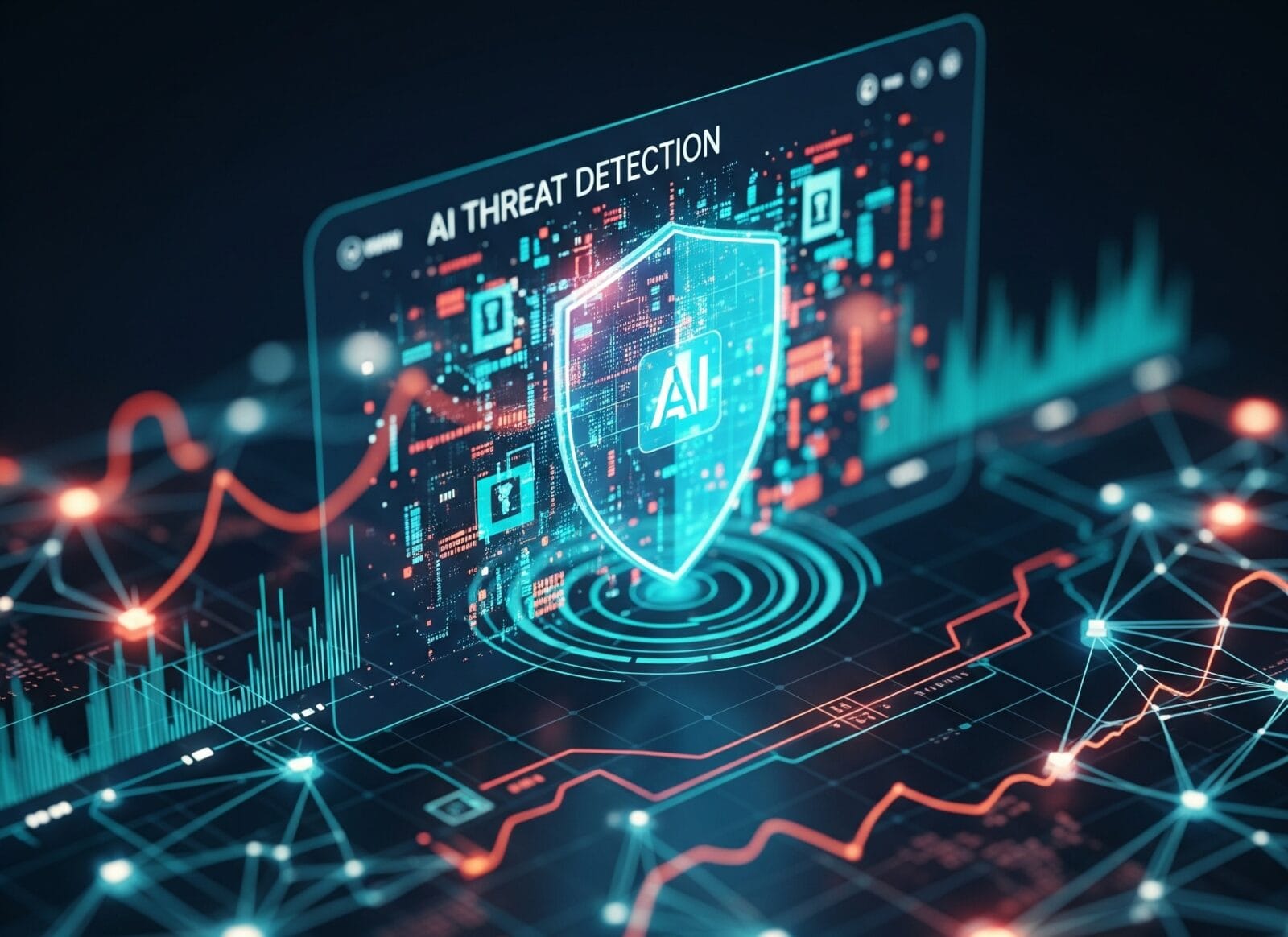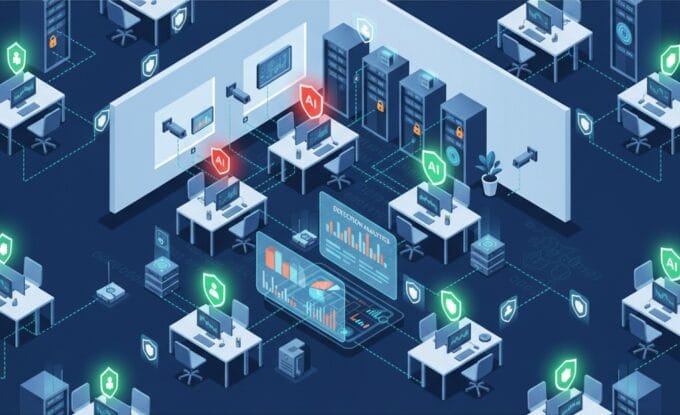In 2025, the cybersecurity landscape is a high-stakes battlefield where the speed and sophistication of attacks are matched only by the ingenuity of defensive technologies. With cybercrime costs projected to exceed $10 trillion this year—a staggering 300% increase in the last decade—and 73% of enterprises having experienced an AI-related security incident in the past 12 months (Metomic, February 2025), the question is no longer if organizations will face a breach, but when and how effectively they can detect and mitigate it. Artificial intelligence has emerged not just as a powerful weapon for attackers, but also as an indispensable shield for defenders.
This article delves into the AI threat detection tools that are proving their worth in 2025, providing tech enthusiasts and small business owners alike with the insights needed to navigate this complex domain. We’ll explore the underlying technologies, highlight leading solutions, present concrete statistics on their efficacy, and discuss how these tools are fundamentally reshaping the approach to cybersecurity.
The Evolving Threat Landscape: Why AI is No Longer Optional
Traditional signature-based security systems, once the bedrock of cybersecurity, are increasingly outmatched by the sheer volume and evolving nature of threats. Cybercriminals are now leveraging AI to craft highly convincing phishing scams, generate adaptive malware, and execute sophisticated social engineering attacks that mimic human behavior (ITNS Consulting, February 2025). This adversarial AI demands a new kind of defense.
The good news is that AI is fighting fire with fire. As of early 2025, 67% of organizations are already using AI as part of their cybersecurity strategy, with 31% relying on it extensively (IBM survey, as cited by JumpCloud). The global AI in cybersecurity market is booming, projected to grow from $35.22 billion in 2025 to $79.09 billion in 2029 at a compound annual growth rate (CAGR) of 22.4% (Research and Markets). This growth underscores the critical role AI plays in modern defense.
How AI Elevates Threat Detection: Beyond Signatures
At its core, AI-powered threat detection excels in three key areas:
- Anomaly Detection: Unlike traditional systems that rely on known threat signatures, AI models learn “normal” behavior patterns within a network, user activity, and data flows. When deviations occur—like a user logging in from an unusual location or a system suddenly receiving large amounts of traffic from a foreign server—AI can flag these anomalies as suspicious, even if they don’t match any previously identified attack (Syracuse University’s iSchool, July 2025).
- Behavioral Analytics: By analyzing vast amounts of data, AI can establish baselines for user and entity behavior. This allows for the detection of insider threats, compromised accounts, and sophisticated attacks that might otherwise go unnoticed. For instance, if an employee account suddenly attempts to access highly sensitive data it never has before, AI can immediately raise an alert.
- Real-Time Processing and Predictive Capabilities: AI can process and correlate massive volumes of security event data in real-time, far surpassing human capabilities. This speed enables rapid detection and response. Furthermore, by analyzing historical data and identifying patterns, AI helps organizations anticipate future threats and proactively strengthen their defenses (iFeeltech, February 2025).
Read More Articles
- Generative AI Cyber Fraud Threatens Businesses With Realistic Scams in 2025
- What is Cyber Fraud in 2025: Your Essential Guide to Staying Safe Online
- Cyber Hygiene in 2025: Essential Implementation Framework for IT Professionals
- ICS Cyber Resilience: Building Business Continuity Beyond Firewalls
- Shadow AI Detection: How to Identify Unauthorized AI Tools in Your Organization
Key AI Threat Detection Tools That Actually Work in 2025
The market for AI-driven cybersecurity solutions is robust, with several categories of tools demonstrating significant effectiveness:
1. AI-Powered Security Information and Event Management (SIEM) and Security Orchestration, Automation, and Response (SOAR) Platforms
Modern SIEM and SOAR platforms leverage AI to revolutionize security operations centers (SOCs). They move beyond simple log aggregation to provide intelligent correlation, automated incident response, and reduced false positives.
- How they work: AI in SIEM/SOAR platforms ingests data from various sources (network devices, endpoints, applications, cloud environments), uses machine learning to identify suspicious patterns, and then automates responses such as blocking malicious IPs, isolating compromised systems, or triggering alerts for human analysts. SOAR capabilities further streamline workflows by orchestrating actions across multiple security tools.
- Why they work: A Ponemon Institute study revealed that 70% of cybersecurity professionals believe AI is highly effective for identifying threats that otherwise would have gone undetected. Organizations with fully deployed AI threat detection systems contained breaches within an average of 214 days, compared to 322 days for those relying on legacy systems (JumpCloud, January 2025). AI improves threat detection by a reported 60% (JumpCloud).
- Leading Solutions in 2025:
- Hunters AI-Driven SIEM: Praised for its ease of use and AI automation, Hunters is designed to help small security teams achieve enterprise-grade threat detection. It leverages “Agentic AI” to autonomously conduct deep, multi-stage investigations, delivering AI-generated conclusions and reducing manual effort (Hunters Security, June 2025).
- CrowdStrike Falcon Next-Gen SIEM: Named a Leader and Fast Mover in the 2025 GigaOm Radar for SIEM, CrowdStrike’s solution integrates endpoint, identity, cloud, and SOAR capabilities. It boasts rapid deployment (up to 3x faster than traditional SIEMs) and significantly faster search times (up to 150x faster) (CrowdStrike, July 2025). CrowdStrike’s Charlotte AI™ Agentic Response and Agentic Workflows are highlighted for accelerating threat investigation and response, reducing false positives by cutting up to 40 hours of time per week for security teams.
- Microsoft Sentinel: Offers robust analysis tools and seamless integration within the Microsoft ecosystem, valued for its scalability and automated responses (PeerSpot, June 2025).
2. Extended Detection and Response (XDR) Platforms
XDR platforms go beyond endpoint detection and response (EDR) by unifying security data across endpoints, networks, cloud environments, and applications. AI is crucial in correlating these diverse data streams to provide a holistic view of threats.
- How they work: XDR solutions use AI to analyze data from multiple security layers, allowing for comprehensive threat detection and automated response actions across the entire IT infrastructure. This consolidation streamlines incident response and eliminates the need for managing multiple disparate security tools.
- Why they work: XDR platforms, powered by AI, offer “unfettered visibility, industry-leading detection, and autonomous response,” according to SentinelOne (PeerSpot, June 2025). They enable faster and more accurate threat detection and response by integrating multiple security layers into a single dashboard.
- Leading Solutions in 2025:
- CrowdStrike Falcon Insight XDR: Leverages AI-driven, real-time threat detection, particularly strong for endpoint-centric XDR with cloud-native architecture (Heimdal Security, June 2025).
- Palo Alto Networks: Cortex XDR: Known for comprehensive threat detection using advanced techniques and 360-degree visibility into the digital environment (Heimdal Security, June 2025).
- SentinelOne: Singularity XDR: Offers an intelligent platform for preventing, detecting, and responding to cyberattacks at machine-speed across endpoint, cloud, and identity (PeerSpot, June 2025).
- Darktrace: A prominent player utilizing “self-learning AI” to detect novel threats without prior knowledge of attack patterns (PeerSpot, June 2025).
3. AI for Zero-Day Exploit Detection and Prevention
Zero-day exploits, which target unknown software vulnerabilities, are among the most dangerous threats. AI plays a crucial role in detecting these attacks by identifying unusual behaviors rather than relying on signatures.
- How they work: AI systems trained on vast datasets of benign and malicious code, system processes, and network traffic can identify anomalous behaviors indicative of a zero-day exploit. This includes unusual memory access, unexpected process creation, or outbound communication from typically quiet applications. Generative AI is even being used by attackers to craft dynamic zero-day exploits, making AI-driven behavioral analytics even more critical for defense (BugBase, March 2025).
- Why they work: AI-driven behavioral analytics and anomaly detection are essential for identifying the subtle cues of zero-day exploits. Tools like Sangfor Engine Zero are designed to detect behavioral anomalies and block zero-day exploits before they cause widespread damage (Sangfor Technologies, July 2025).
- Example: While specific product names for this niche are evolving rapidly, solutions integrated into comprehensive XDR and EDR platforms are increasingly incorporating advanced AI for zero-day detection.
4. AI-Powered Phishing and Social Engineering Prevention
Phishing and social engineering attacks are becoming increasingly sophisticated, with AI generating highly convincing emails and even mimicking voices. AI-powered tools are vital in combating these threats.
- How they work: AI uses natural language processing (NLP) to analyze the tone, content, and structure of emails and messages. It can detect subtle cues of deception, such as urgent wording, suspicious sender domains, or unusual attachments. AI can also learn from user interactions (what they open, ignore, or report) to improve its detection capabilities over time.
- Why they work: Deep Instinct’s security professionals found that AI-driven tools prevent phishing at a 92% rate compared to 60% for legacy systems. Research at Cornell University demonstrated that browser extensions equipped with machine learning capabilities effectively detected over 98% of phishin1g attempts (JumpCloud, January 2025). Microsoft’s AI tools have analyzed trillions of security signals and stopped over 35 billion phishing attacks.
- Solutions: Many endpoint protection platforms, email security gateways, and cloud security solutions integrate AI for advanced phishing detection.
AI Threat Detection for Small Business Owners and Tech Enthusiasts
While large enterprises deploy complex, multi-layered AI security architectures, small business owners and tech enthusiasts can still leverage powerful AI threat detection tools.
- Cost-Efficiency: Many AI-driven solutions are now cloud-based, reducing the need for expensive on-premise infrastructure. Solutions like ThreatDown from Malwarebytes offer enterprise-level protection at accessible price points (iFeeltech, February 2025).
- Simplified Management: Consolidated solutions that combine multiple functions (e.g., threat detection, firewall management) into one platform simplify security management.
- Continuous Monitoring: AI operates 24/7, continuously monitoring for anomalies and potential threats, even during off-hours, ensuring no suspicious activity goes unnoticed.
- Actionable Steps for Small Businesses/Enthusiasts:
- Assess Your Needs: Understand your critical assets and most likely threats (e.g., phishing, ransomware).
- Adopt Targeted Tools: Focus on solutions providing comprehensive coverage. Consider endpoint protection with AI capabilities (e.g., from Malwarebytes, CrowdStrike, SentinelOne), and leverage built-in security features in platforms like Google Workspace or Microsoft 365.
- Integrate Seamlessly: Choose tools that work well with your existing systems.
- Train Employees: Education on recognizing phishing and using multi-factor authentication (MFA) remains crucial.
- Monitor and Update Regularly: Apply updates promptly and review system performance.
- Start Small: Begin with essential tools and gradually expand as needed.
The Human Element: AI as an Enabler, Not a Replacement
It’s important to note that while AI significantly enhances threat detection, it does not fully replace the human element in cybersecurity. As the Syracuse University’s iSchool report (July 2025) highlights, “AI can handle the heavy lifting: monitoring traffic, spotting anomalies, filtering noise, and reacting quickly to low-risk issues. Meanwhile, human analysts still need to review complex threats, understand context, and make judgment calls that AI 2can’t.”
In fact, only 12% of security professionals believe AI will fully replace their roles, with the majority viewing AI as an enhancement to human expertise (ZERO Threat, June 2025). Dedicated AI security teams detected breaches 72% faster than those without, and implementing specialized monitoring for AI systems reduced breach costs by an average of 31% (Metomic, February 2025).
Conclusion: Staying Ahead in 2025
The battle against cyber threats in 2025 is increasingly defined by the effective deployment of AI. From sophisticated SIEM/SOAR platforms that automate responses to XDR solutions that provide comprehensive visibility, and tools designed to ferret out elusive zero-day exploits, AI is a non-negotiable component of a robust cybersecurity strategy. For tech enthusiasts looking to stay informed and small business owners seeking practical protection, understanding and adopting these AI-powered tools is paramount.
By prioritizing factual accuracy, embracing behavioral analytics, and leveraging the rapid processing power of machine learning, organizations and individuals can significantly bolster their defenses against the ever-evolving array of cyber threats. The future of cybersecurity is intrinsically linked with AI, and those who harness its power will be the ones that actually work in 2025 and beyond.
Subscribe to our newsletter for more insights into the cutting-edge of cybersecurity and AI innovation!

















Leave a comment